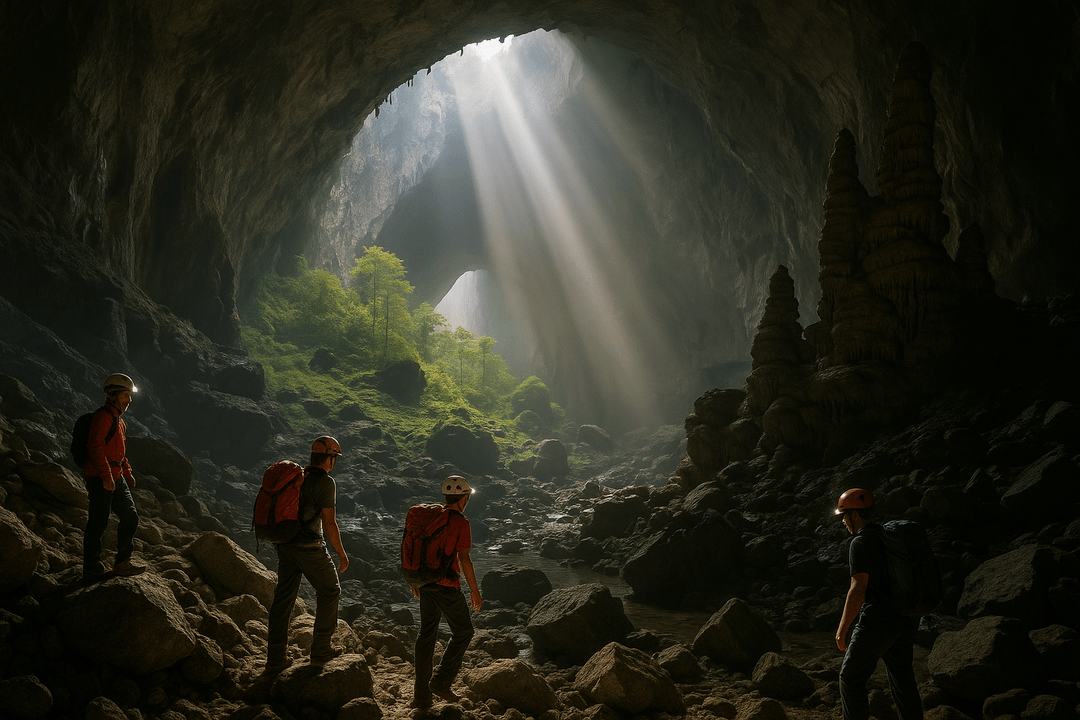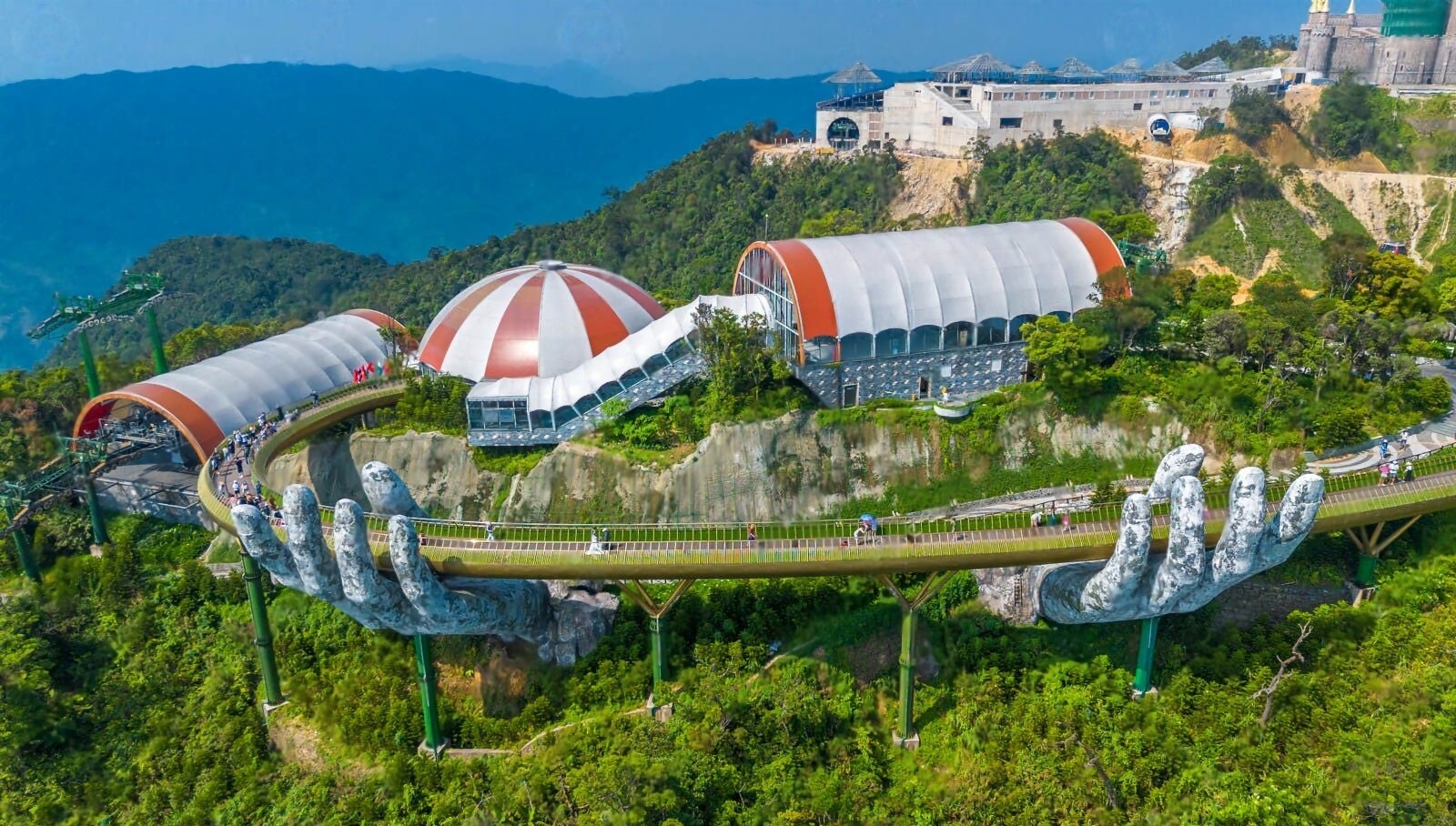The Amazing Discovery of World’s largest cave
The world’s largest cave in Vietnam is something truly special. Son Doong Cave sits hidden in the lush jungles of Vietnam’s Phong Nha-Ke Bang National Park. And it’s so big that it’s hard to believe it’s real. This massive cave stayed secret for years until a local man named Ho Khanh found it by accident in 1990.
Cave might not be available right now, but Gomayu offers exclusive Vietnam packages to other destinations and can customize them according to your preferences.
Ho Khanh wasn’t a scientist or explorer. He was a farmer and jungle man who often ventured into the forest to collect aloe wood. Aloe wood a valuable resource used in making incense. One day while foraging in a remote area of the jungle, he took shelter from a rainstorm near a mountain. That’s when he noticed something unusual, a hole in the limestone cliff with mist coming out. He could hear the sound of a river rushing far below and felt a strong wind blowing from the opening.
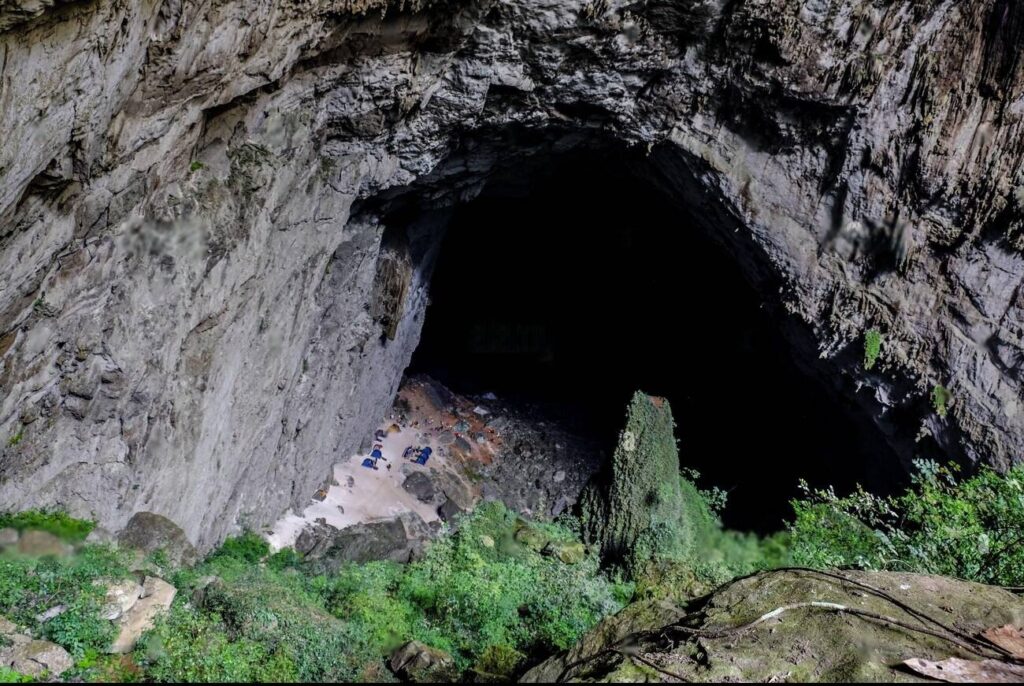
According to Ho Khanh, “The wind and sound of the cave were unusual. It gave me the chills, and I remember thinking it might be home to ghosts or creatures from local legends.” These sensations made him nervous. And he decided not to venture inside the mysterious opening. He simply noted its location and continued his journey home.
When he later tried to find the cave again, the dense jungle had obscured the entrance. The world’s largest cave remained a secret for almost 20 more years. It existed only as an occasional story Ho Khanh would tell. About the strange hole in the mountain with wind and clouds coming out.
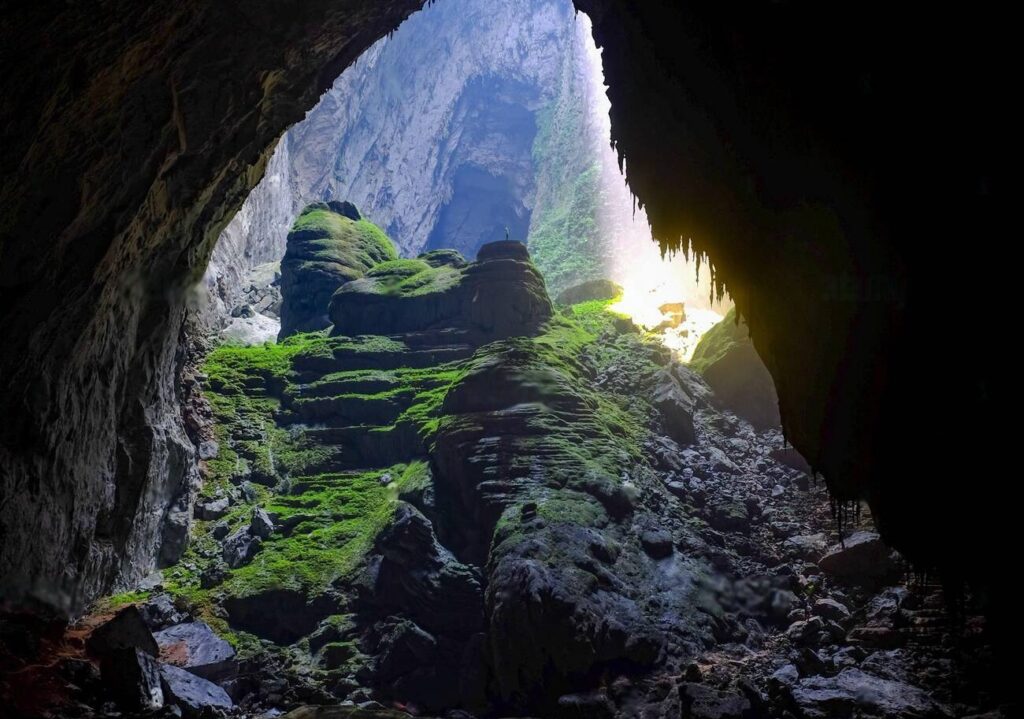
The story might have ended there. And the world’s largest cave in Vietnam remaining hidden forever. But in 2006, British cave experts Howard and Deb Limbert came to Vietnam. While surveying caves in the region for the British Cave Research Association. They heard rumors from locals about a massive cave with a river inside. Howard Limbert recalls, “The local people mentioned huge cave with a river & jungle. But no one could tell us exactly where it was.”
The British team spent years searching the jungle without success. Finally, in 2008, Ho Khanh rediscovered the entrance while on another foraging trip. This time, he carefully marked the trail. And took note of distinctive features in the landscape so he could find it again.
In 2009, Ho Khanh guided Howard Limbert and a team of British cavers. To the mysterious opening he had found nearly two decades earlier. What they discovered inside exceeded everyone’s expectations. The cave wasn’t just large it was colossal, dwarfing any other known cave chamber on Earth.
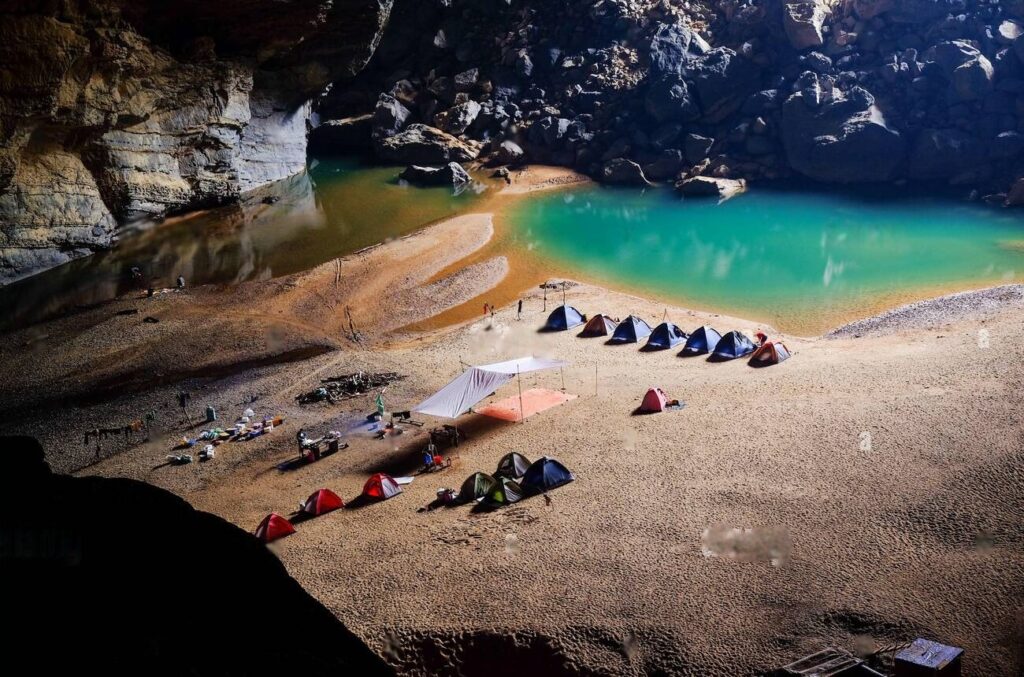
After measurements, they announced that Son Doong was officially the world’s largest cave. It has a volume of 38.5 million cubic meters. Howard Limbert described their initial reaction: “We were absolutely stunned. None of us had ever seen anything like it. The scale was beyond anything we could have imagined.”
The discovery made headlines around the world. National Geographic featured the cave in a 2011 issue. They brought global attention hidden cave in Vietnam’s jungle for millions of years. In 2013, the Guinness World Records officially recognized. Son Doong as the world’s largest cave by volume.
The world’s largest cave remained unknown to science until the 21st century. Its an age of satellite mapping and global exploration. But Son Doong reminds us that our planet still holds magnificent secrets waiting to be found. Ho Khanh, a local man knowledge of the forest proved to be successful than modern technology.
How Big Is the World’s Largest Cave in Vietnam?
It’s hard to imagine just how big Son Doong Cave really is. Let me try to explain it:
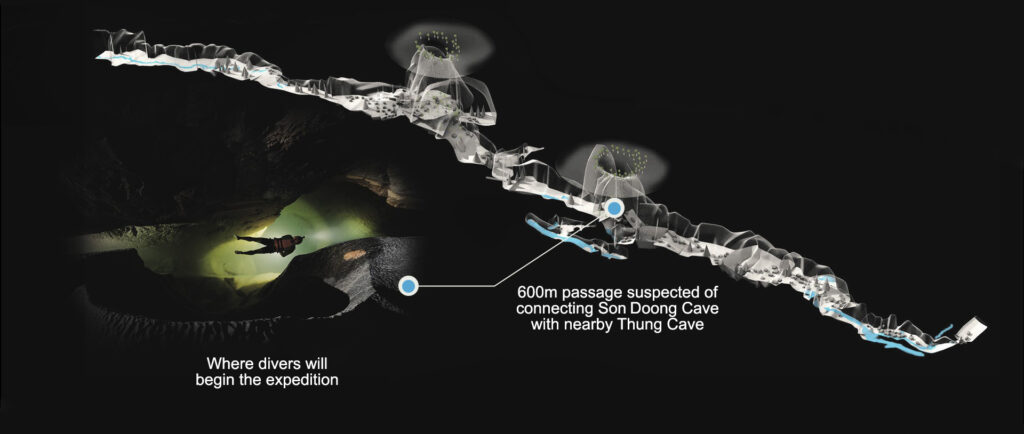
- It’s more than 9 kilometers (5.6 miles) long
- Some sections are 200 meters (660 feet) high tall enough to fit a 40-story skyscraper
- The cave is 150 meters (490 feet) wide in places
- You could fly a Boeing 747 airplane through the main passage without touching the walls
- The cave is so massive it has its own river, jungle, and weather system
When you stand inside the world’s largest cave, you feel tiny. The spaces are so huge that clouds actually form inside the cave! No other cave in the world has been found that matches Son Doong’s incredible size.
How Nature Created This Wonder
The world’s largest cave in Vietnam didn’t form overnight. Son Doong began forming 2-5 million years ago through a fascinating geological process. Let’s take a closer look at how nature created this underground marvel.
The story begins with the limestone mountains of central Vietnam. These mountains formed around 400 million years ago when the area was covered by an ancient sea. Tiny marine creatures lived and died. Their shells and skeletons slowly building up on the seafloor. Over millions of years, these remains were compressed into limestone rock.
Fast forward to around 5 million years ago. The land had risen, and the limestone was now exposed to the elements. Rainwater, which is naturally slightly acidic, began seeping into cracks in the limestone. This is where the magic starts. The acidic water slowly dissolved the calcium carbonate in the rock. It creates spaces that grew larger over time.
The Rao Thuong River played a crucial role in Son Doong’s formation. As this river flowed across the landscape, it found its way into the weakened limestone. And began flowing underground. The constant movement of water accelerated the cave-forming process. And carrying away dissolved minerals and eroding the passageway.
What makes Son Doong unique is that it formed along a fault line in the Truong Son mountain range. This geological weakness allowed the cave to develop on a truly massive scale. As water continued to flow through for millions of years. It carved out the enormous tunnel that would become the world’s largest cave.
In some places, the ceiling was weak and collapsed. It created huge skylights called “dolines.” These dramatic openings let sunlight into the cave for the first time. Scientists estimate these collapses happened several hundred thousand years ago.
Light and water now available inside. Something amazing happened plants started growing inside the world’s largest cave! Seeds carried by wind, water, or animals found their way into these sunlit areas. It took root, beginning the development of the unique ecosystems we see today.
The cave continues to evolve even now. Water still flows through Son Doong, dissolved minerals still form new deposits. And occasional rockfalls still reshape passages. The world’s largest cave in Vietnam isn’t a static formation. It’s a living, changing natural wonder that continues to develop before our eyes.
The Amazing Ecosystem Inside
What makes Son Doong truly special isn’t just its size but what lives inside. The world’s largest cave in Vietnam has its own complete ecosystem. It has amazed scientists and visitors alike.
When you visit Son Doong, you’ll see actual jungles growing inside the cave. These aren’t small patches of plants, they’re full forests with their own complex web of life. Near the dolines, where sunlight pours in through the cave ceiling, trees grow as tall as 30 meters (98 feet). These cave forests are known as “Gardens of Edam“. After the two researchers who first documented them.
The plant life in Son Doong is incredibly diverse. Lush ferns carpet the ground in many areas. Vines climb up the walls toward the light. Moss covers rocks in beautiful green patterns where moisture is plentiful. Over 200 different plant species have been identified within the world’s largest cave.
Animals have found their way into this underground oasis too. Monkeys from the surrounding jungle sometimes venture into the cave through the dolines. They feed on fruits from the trees growing inside. Birds, including swifts and swiftlets, nest in the upper reaches of the cave walls. Bats hang from the ceiling in quieter sections of the cave, emerging at dusk to feed.
Most interesting are the creatures that have adapted to the darkness of Son Doong. The cave’s river contains white fish and translucent shrimp that evolved without eyes. They don’t need them in the pitch-black sections of the world’s largest cave in Vietnam. Scientists have also discovered unique species of spiders, centipedes, and other arthropods. These exist nowhere else on Earth.
The microbial life in Son Doong deserves special mention. Bacteria and other microorganisms thrive in this environment. It creates colorful biofilms on some of the wet surfaces. These tiny life forms play an essential role in the cave’s ecosystem. Breaking down organic matter and providing food for larger organisms.
What truly sets Son Doong apart is its internal weather system. The temperature difference between cave (a steady 73°F/23°C) & outside world create air currents. This form clouds within the massive chambers. These clouds drift through the cave passages, creating an ethereal atmosphere. In the morning warm air from outside meets the cooler cave air. And thick mist forms in the dolines, creating a mystical scene as sunbeams cut through the fog.
During Vietnam’s rainy season, water can pour through the dolines. It creates temporary waterfalls that cascade hundreds of feet to the cave floor. Dramatic waterfalls disappearing into the darkness of the world’s largest cave is surreal.
Researchers believe we’ve only begun to understand the complex ecosystem of Son Doong. Each scientific expedition discovers new species and relationships within this isolated world. The cave represents a laboratory for studying how life adapts to extreme environments. And also how ecosystems develop when largely separated from the outside world.
Exploring the World’s Largest Cave
Visiting Son Doong isn’t like other tourist attractions. Every aspect of exploring the world’s largest cave in Vietnam is extraordinary. From the limited access to the physical challenges involved.
Only Oxalis Adventure is authorized by the Vietnamese government to bring visitors to Son Doong. This exclusive arrangement helps protect the fragile ecosystem. And ensure safety standards are maintained. Oxalis works in partnership with British cave experts. It including members of the original expedition that surveyed Son Doong.
Access to the world’s largest cave is strictly controlled. Only about 1,000 people allowed to visit each year. This limited number helps minimize human impact on the cave environment. To put this in perspective. Popular tourist sites like the Grand Canyon receive millions of visitors annually. The restricted numbers make Son Doong expedition spots highly coveted. Often booking out 1-2 years in advance.
The journey to explore the world’s largest cave takes 4-5 days. And it’s designed as a true expedition rather than a casual tourist experience. The adventure typically follows this schedule:
Day 1: Participants meet in Phong Nha before traveling to the trailhead. From there, they trek through dense jungle for 8-9 kilometers (5-5.6 miles) to reach Hang En cave. The third-largest cave in the world, where they spend their first night camping.
Day 2: After exploring Hang En, the group continues to Son Doong entrance. Using safety harnesses and with expert guidance. They descend into the cave’s first section. This day involves navigating boulder piles. Getting the first glimpse of the cave’s enormous dimensions.
Day 3: The expedition continues deeper into Son Doong. Passing the first doline (skylight) and visiting the cave jungle. This day often includes some of the most spectacular photography opportunities. In the world’s largest cave in Vietnam.
Day 4: The group tackles one of the expedition’s biggest challenges. It is scaling the 90-meter “Great Wall of Vietnam” using ropes and harnesses. Beyond this calcite barrier, they explore the second doline. And more breathtaking cave formations.
Day 5: The final day involves exiting the cave and trekking back through the jungle to Phong Nha.
The physical demands are significant. Participants must pass a health screening before being accepted. The minimum age is 18. People with certain medical conditions are advised not to participate. Including heart problems, high blood pressure, and respiratory issues.
The expedition isn’t cheap as it costs around $3,000 per person. This price reflects the exclusive nature of the experience. The expert guides, camping equipment, meals, and permits.
The cost and physical challenges are high. But who’ve made the journey say exploring the world’s largest cave is a unreal experience. It changes how they view our planet. Many describe it as the most remarkable adventure of their lives. Standing in chambers so vast they disappear into darkness. Witnessing ecosystems that have developed in isolation. And experiencing the profound silence of deep cave sections.
You might not be unable to secure a spot or looking for less demanding alternatives. Oxalis offers other cave expeditions in the area, including tours of Hang En Cave and Tu Lan Cave System. While not as large as the world’s largest cave in Vietnam. But these offer similarly magical experiences with fewer physical demands and lower costs.
Here’s the video from the famous Ruhi cenet, who dare to do riskiest exploration! It’s about exploration of Son Doong.
Amazing Features Inside Son Doong
As you visit the world’s largest cave in Vietnam, you’ll see formations and features. They seem to belong in a fantasy novel rather than the real world. Let’s explore some of the most spectacular sights that await inside Son Doong.
The Great Wall of Vietnam
This massive 90-meter (300-foot) high wall of calcite is so impressive. Explorers named it after the famous Great Wall of China. The formation developed over thousands of year. It deposited thin layers of calcite with each drop.
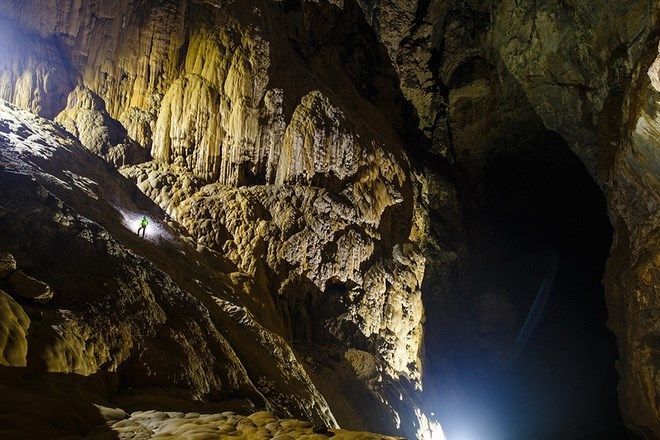
The British exploration team first encountered this enormous flowstone in 2009. They lacked the equipment to scale it safely. They had to return in 2010 with proper climbing gear to finally reach the top. And continue exploring the cave. Today, visitors to the world’s largest cave climb barrier using ropes and harnesses. Also, with expert safety assistants ensuring a secure ascent.
The wall’s surface features cascading terraces of stone. They shimmer when illuminated by headlamps. The calcite appears in shades ranging from pure white to amber and rust. It depends on the minerals present when each layer formed. Standing at the base of formation gives visitors a sense of nature’s patient artistry.
The Cave Pearls
In the world’s largest cave in Vietnam you’ll find one of the rarest thing. It is the most beautiful cave formations, cave pearls. These round stone develop when mineral-laden water drips onto grains of sand or rock. As the water splashes, it creates tiny waves that coat the grain evenly on all sides. Over centuries, layer upon layer builds up, creating these spherical treasures.
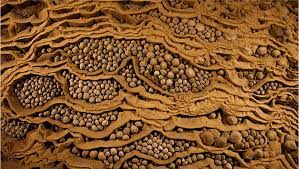
Son Doong contains some of the largest cave pearls ever discovered. Most cave pearls found worldwide are pea-sized. Those in Son Doong can reach the size of baseballs. They’re often found in “gour pools” natural stone basins filled with water. They look like precious gems scattered across the cave floor.
The perfect roundness of these formations makes them appear almost manufactured. But they’re entirely natural the result of water, minerals, and time coming together.
The Towering Stalagmites
Son Doong contains some of the tallest stalagmites ever discovered in a cave. With some reaching an astonishing 80 meters (260 feet) in height. To put this in perspective, that’s about the height of a 25-story building growing up from the cave floor!
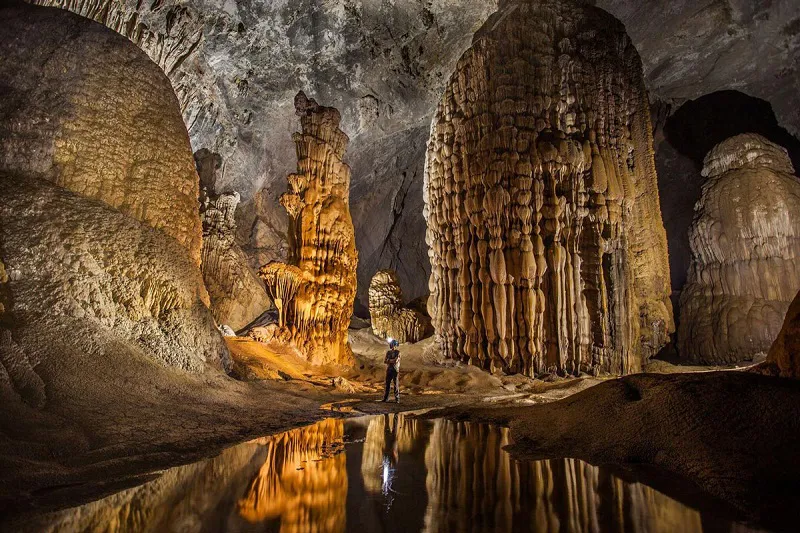
These stone giants form incredibly slowly as water drips from the ceiling. It depositing tiny amounts of minerals with each drop. Scientists estimate that stalagmites grow at roughly 0.13mm per year. The towering formations in Son Doong began forming hundred of thousands of years ago.
The stalagmites in the world’s largest cave take on fantastical shapes. Some of them resemble melted candles. Others look like tiered wedding cakes, and some grow in slim columns that seem to defy gravity. Their surfaces are often textured with ripples and ridges. It recording changes in water flow and mineral content over vast periods.
The Two Dolines
Perhaps the most dramatic features of Son Doong are its two enormous dolines. It is places where the cave ceiling collapsed. And creates natural skylights that allow sunlight to penetrate deep underground. These openings are sometimes called the “eye of the cave”. It create some of the most magical scenes in the world’s largest cave in Vietnam.
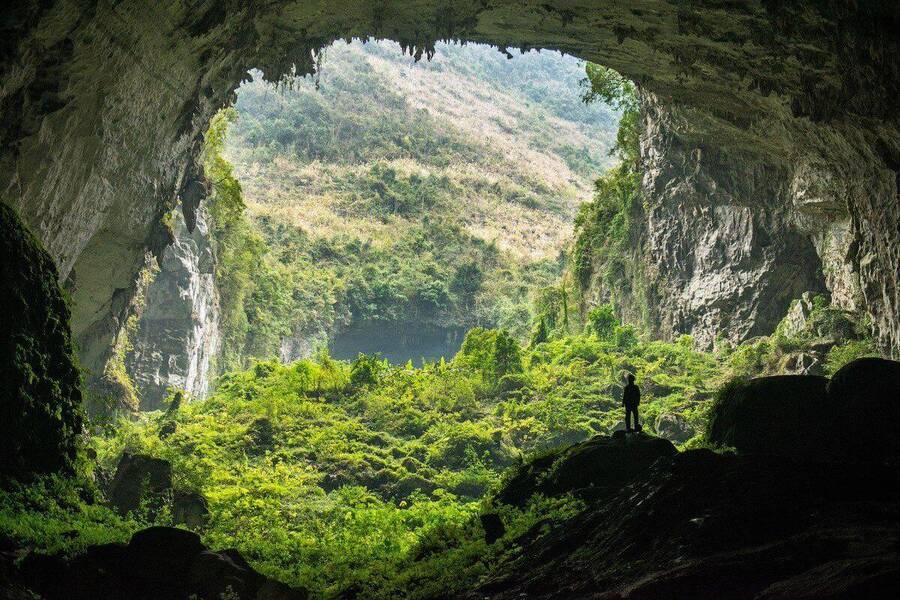
The first doline you encounter when exploring Son Doong is about 2.5 kilometers (1.6 miles) from the entrance. Here, a massive opening over 100 meters (330 feet) across lets sunlight pour into the darkness. The bright beam of light cutting through the gloom creates an otherworldly atmosphere. Especially when morning mist catches the rays.
The second doline, “Watch Out for Dinosaurs” got its name with its primeval appearance. It is even more spectacular. An entire jungle thrives in the sunlight that streams through the ceiling opening. The lush green plants and the dark stone of the surrounding cave creates a scene straight out of a movie set.
These dolines aren’t just beautiful. They’re crucial to the cave’s ecosystem. They allow light and fresh nutrients to enter the underground world. It supports the unique forests that have developed inside the world’s largest cave.
The Underground River
A powerful river flows through parts of Son Doong. The same one that helped carve out the cave over millions of years. This isn’t a small stream in some sections. It’s a substantial waterway that adventurers must cross several times. During their expedition through the world’s largest cave in Vietnam.
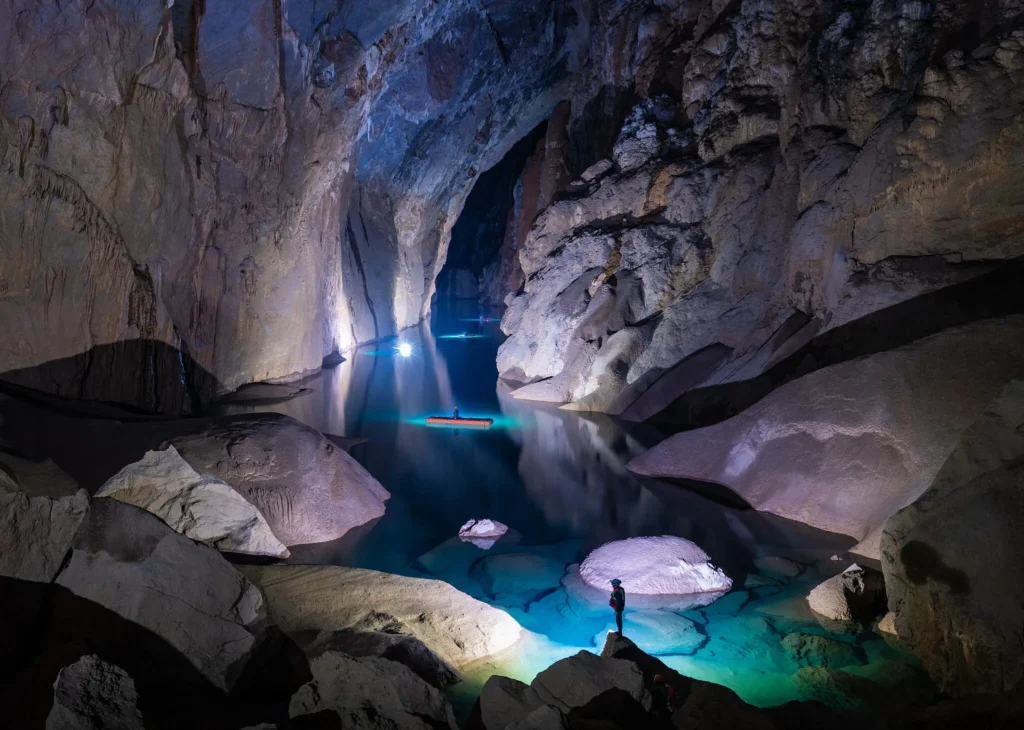
The river enters the cave from Hang Thung. And continues through much of Son Doong before disappearing into lower passages. During the rainy season (September to November), water levels can rise dramatically. That is why cave expeditions only run during the drier months.
The water in the river is remarkably clear in most sections. Allowing visitors to see the sculpted stone beneath the surface. In deeper pools, the water takes on a mesmerizing turquoise color. That contrasts beautifully with the darker stone of the cave walls.
Along the expedition route, visitors have the opportunity. It’s to swim in one of the river’s deeper pools a refreshing experience after the challenging trek. Floating in cool water while gazing up at the cavern above is an unforgettable moment. For many who explore the world’s largest cave.
The Fossil Passage
One section of Son Doong is known as the Fossil Passage. It contains remarkable evidence of the region’s ancient past. Here, the cave walls are embedded with marine fossils the remains of sea creatures. That lived hundreds of millions of years ago when the area was covered by ocean.
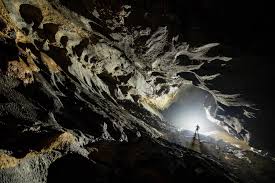
These fossils include ancient corals, shells, and the remains of primitive sea creatures. All preserved in the limestone for eternity. The rock in world’s largest cave formed through marine sediment in a long-vanished sea.
Ancient remains in the cave walls gives visitors a profound connection to old time. The story of Son Doong began long before the cave itself existed. As ancient seas teeming with life that would later become part of underground world.
Preserving a Natural Wonder
The world’s largest cave in Vietnam created both opportunities and challenges for conservation. How do you protect something so magnificent? while still allowing people to experience its wonders? This question has shaped the management approach to Son Doong since its discovery.
Son Doong was first surveyed in 2009. Experts immediately recognized its global significance and vulnerability. The cave had remained virtually untouched for millions of years. Developing its unique formations and ecosystems in isolation. Suddenly opening it to mass tourism could irreparably damage this pristine environment.
The Vietnamese government with international cave experts, developed a conservation plan. It prioritizes protection while allowing limited sustainable tourism. This balanced approach has several key components:
Strict Visitor Limitations
Unlike many natural attractions access to the world’s largest cave is tightly controlled. Only 1,000 visitors per year are permitted to enter Son Doong. That’s just 10 people per expedition, with approximately 100 expeditions annually. This strict quota helps minimize human impact on the fragile cave environment.
For comparison, Vietnam’s popular Ha Long Bay receives around 7 million visitors annually. The extreme limitation on Son Doong visitors demonstrates the seriousness. In which authorities view cave conservation.
Single Authorized Operator
Only one tour company, Oxalis Adventure, is licensed. To bring visitors to the world’s largest cave in Vietnam. This exclusive arrangement allows for tight quality control. And ensures all guides follow strict conservation protocols. Guides and support staff receive extensive training. It’s about minimal-impact caving techniques and environmental education.
The single operator model also simplifies monitoring and accountability. If any damage occurs. Authorities know exactly who was responsible and can take immediate action.
Scientific Oversight
All operations in Son Doong are conducted under the supervision of scientific advisors. It includes British cave experts who were part of the original exploration team. These specialists regularly assess the cave’s condition. Then, recommend adjustments to visitor routes or procedures if there is negative impacts.
Research activities within the world’s largest cave must be approved and monitored. Scientists studying the cave’s geology, biology, or archaeology must demonstrate. That work will not harm the cave environment & share findings with Vietnamese authorities.
Infrastructure Limitations
Unlike tourist caves worldwide, Son Doong has been kept free from permanent infrastructure. There are no installed lights, paved paths, or handrails. Visitors use headlamps to navigate, walk on natural surfaces. And camp using low-impact equipment that’s carried out after use.
This minimalist approach preserves the cave’s natural appearance. And avoids the environmental disruption that construction would cause. It also provides visitors with a more authentic experience of the cave in its natural state.
Rejected Development Proposals
Since Son Doong gained international fame, there are several proposals for intensive development. It included a controversial plan to build a cable car system into the cave. This $213 million project would have increased visitor numbers. But would have required excessive construction inside the world’s largest cave.
Significant outcry from environmentalists, scientists, and the public were seen. Vietnamese authorities rejected the cable car proposal in 2019. This decision demonstrated a commitment to conservation over short-term tourism profits. And also setting an important precedent for the cave’s future management.
Local Community Involvement
Effective conservation requires the support of local communities. The Son Doong conservation model includes significant roles for residents of nearby villages. They work as porters, support staff, and as trained guides. All for expeditions to the world’s largest cave in Vietnam.
This approach provides sustainable livelihoods that are tied to cave conservation. It also creates local economic incentives to protect. Many staffs come from families that relied on logging, hunting, or other activity.
Educational Component
Every expedition to Son Doong includes comprehensive education. It’s about cave formation, ecology, and conservation. Visitors learn about the world’s largest cave. Also about the broader importance of protecting karst landscapes and underground ecosystems worldwide.
This educational emphasis helps create a community of advocates. They understand and can communicate the value of cave conservation. Many visitors become passionate champions for protecting Son Doong. After experiencing its wonders firsthand.
Future Conservation Challenges
Despite these strong protections, Son Doong faces ongoing conservation challenges. Climate change may alter the regional hydrology. Potentially affecting water flow through the cave. Increased development in surrounding areas could impact water quality. It might create new pressures to open the cave to more tourism.
The world’s largest cave in Vietnam sits within a complex ecosystem. That extends far beyond its entrances. Protecting Son Doong requires protecting the entire watershed that feeds it. The forest above it, and the broader karst landscape of which it’s a part. This holistic conservation approach is challenging. But essential for preserving this natural wonder for future generations.
Beyond Son Doong: Vietnam’s Cave Kingdom
While Son Doong is the crown jewel, the entire Phong Nha-Ke Bang National Park is known as “The Kingdom of Caves.” This UNESCO World Heritage site contains over 400 discovered caves. It includes many of the largest caves in the world.
Some other impressive caves near the world’s largest cave in Vietnam include:
- Hang En Cave: The third-largest cave in the world and home to thousands of swiftlets (birds)
- Paradise Cave: Features spectacular formations along its 31-kilometer length
- Phong Nha Cave: Can be explored by boat as a river flows through it
- Tu Lan Cave System: Features beautiful swimming caves and waterfalls
Anyone interested in visiting the world’s largest cave but unable can explore options. While not as large as Son Doong, they offer equally magical experiences.
The Future of the World’s Largest Cave
Scientists believe the world’s largest cave in Vietnam is bigger than currently known. In 2019, breakthrough took. When British divers Jason Mallinson and Rick Stanton explored Son Doong’s underwater passages. Rick Stanton is same divers who helped rescue the trapped Thai soccer team from Tham Luang cave in 2018)
These expert cave divers discovered a connection between Son Doong and Hang Thung. They swam through a completely submerged tunnel about 600 feet (183 meters) long. And emerged into Hang Thung cave on the other side. It proved that Son Doong is part of an even larger cave system than previously thought.
Howard Limbert that surveyed Son Doong, explained the significance. “This connection means Son Doong is even larger than we thought. Any cave in the world will be able to fit inside Son Doong when it’s connected it’s outrageous in size.”
Divers have proven the physical connection exists officially. It connects the two caves. For measurement purposes requires mapping the exact dimensions of the underwater passage. This challenging task remains for future expeditions. When the connection is officially documented. The world’s largest cave in Vietnam will gain at least 1.6 million cubic meters in volume.
Research continues on many fronts inside Son Doong. Biologists are particularly interested in the cave’s isolated ecosystems. It may have evolved independently for thousands or even millions of years. Several species new to science have already been discovered in the cave. It includes a translucent cave fish, unique insects, and previously unknown microorganisms.
Dr. Anette Becher is a biologist who has studied Son Doong’s ecosystem. She says, “The cave contains biological communities. They have been isolated from the outside world for incredibly long periods. This makes it a natural laboratory for studying evolution. In isolation similar to how scientists study unique species on islands.”
Climate scientists are also studying the world’s largest cave. It has a record of ancient climate conditions. The stalactites and stalagmites in Son Doong contain layers. It is like tree rings that can reveal information about rainfall patterns. And also, temperatures going back hundreds of thousands of years. These natural archives may help scientists better understand how Earth’s climate has changed.
Geologists continue mapping the cave in ever greater detail. They are using advanced technology like 3D laser to create precise digital models. Detailed maps help scientists understand how the cave formed and continues to evolve. They also assist in conservation efforts by documenting the cave’s current condition. It is a baseline for future monitoring.
The future of Son Doong will likely involve a careful balance. Between scientific research, limited tourism, and strict conservation. Vietnamese authorities have shown a commitment to protecting this natural treasure. While allowing people to experience its wonders in a sustainable way.
Perhaps the most exciting aspect of the world’s largest cave is what remains to be discovered. What other passages might branch off from the main chamber? What unique life forms might still be hiding in its darkest corners? What will we learn about Earth’s past from studying its ancient formations? Son Doong continues to inspire questions and spark curiosity.
Planning Your Visit
If you’re inspired to see the world’s largest cave in Vietnam for yourself, here’s what you need to know:
- Book far in advance, spots fill up 1-2 years ahead
- Tours only run January through August
- Be prepared for physical challenges including jungle trekking, river crossings, and climbing
- Basic camping gear is provided, but bring good hiking boots and appropriate clothing
- The expedition costs around $3,000 per person
- A good level of fitness is required
While not everyone will have the chance to explore the world’s largest cave. We can all appreciate the wonder of Son Doong and support efforts to protect it. Through photos, videos, and stories shared by those lucky enough to visit. We can experience some of the magic of this underground kingdom. But if you want to visit Vietnam, Remember Gomayu for customize Vietnam tour.
Son Doong: Cave Still Alive!
The story of Son Doong from its chance discovery to its recognition. It is the world’s largest cave in Vietnam. It’s a real magic and a reminder that our planet still holds magnificent secrets.
This massive cave shows us the powerful forces of nature at work over millions of years. Water, time, and geology combined to create an entire world beneath the surface. It has its own forests, rivers, weather, and unique life forms.
The world’s largest cave in Vietnam stands our planet’s most remarkable natural wonders. It is a place where adventure, science, conservation, and natural beauty come together. Son Doong is one of the incredible natural heritage we all share and must protect.
In a world that sometimes feels fully mapped and explored. The recent discovery of the world’s largest cave gives us hope that wonders awaits. Perhaps they’re hiding in plain sight. Just waiting for the right moment and the right explorer to reveal their secrets to the world.d.



